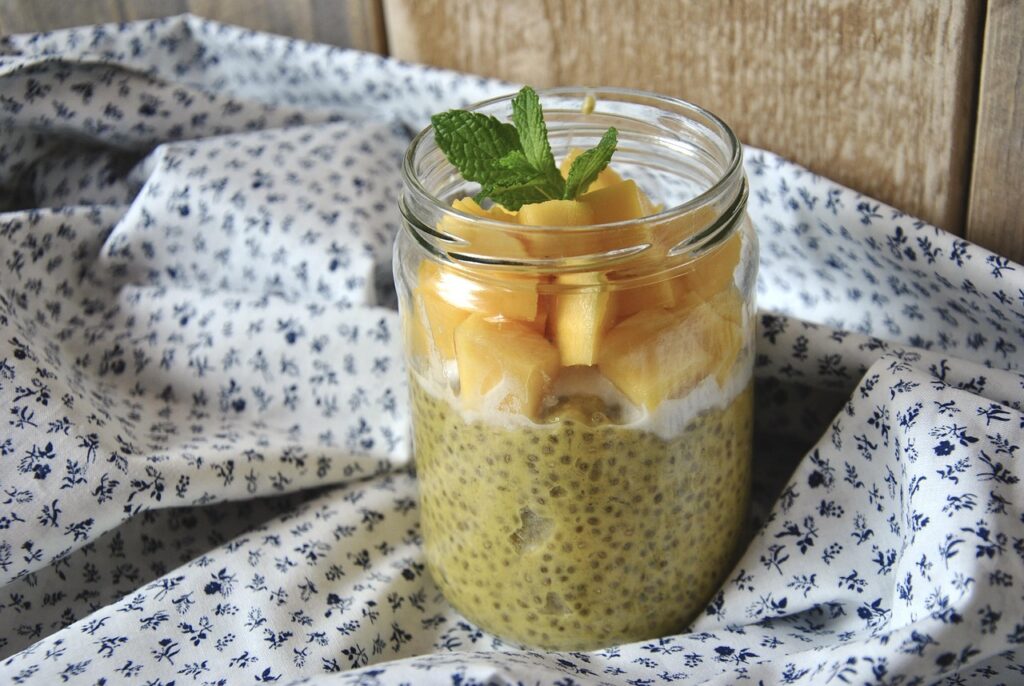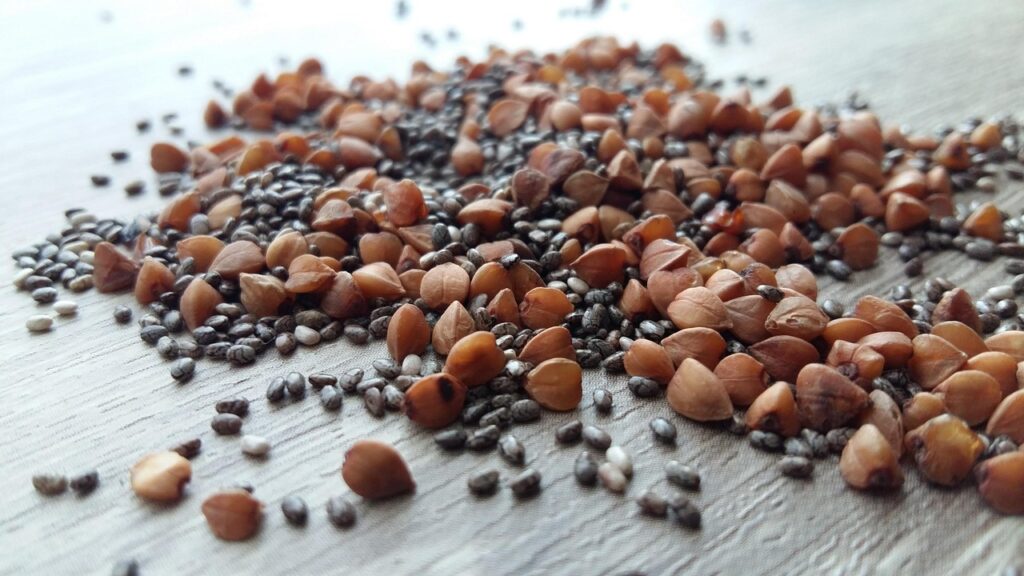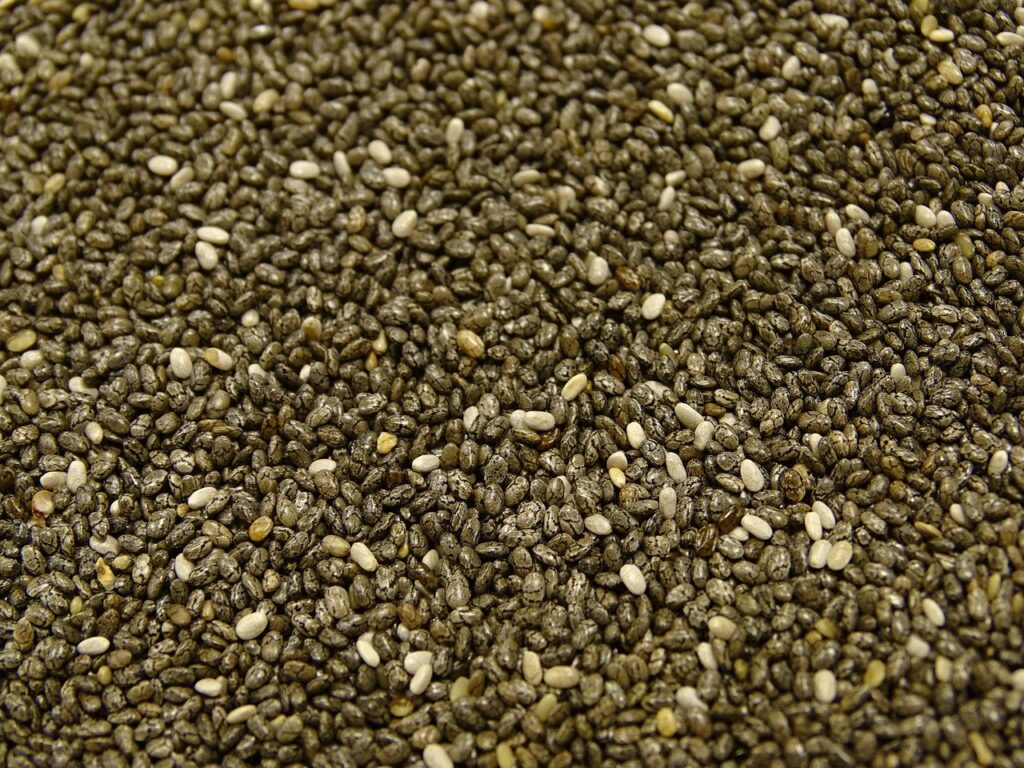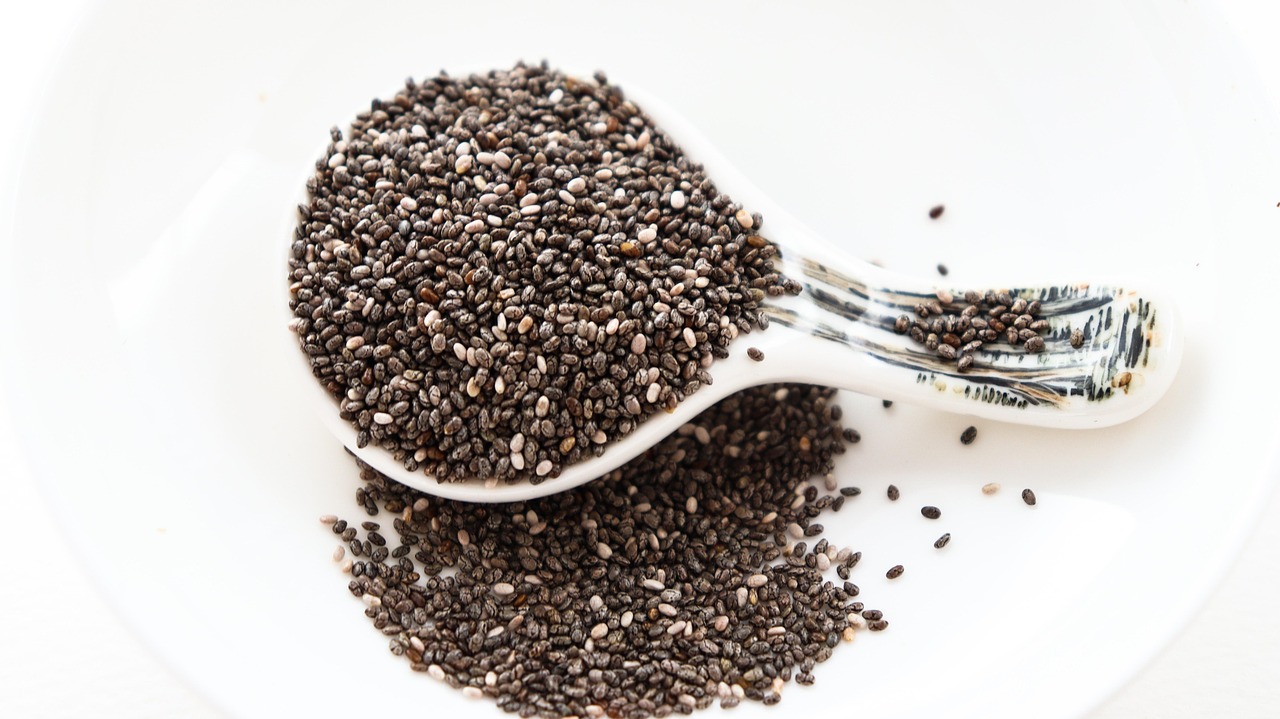Chia Seed Basics and Benefits
Chia seeds work in our daily lives not with flashiness but with a kind of quiet strength. When the tiny dry seeds are soaked in water, a polysaccharide gel called mucilage seeps from the seed coat and wraps each grain in a springy layer. That pleasant, bouncy mouthfeel is more than a culinary trick. Because the viscous gel holds on to liquid, gastric emptying and diffusion in the small intestine become gentler, and the absorption rate of sugars and fats naturally slows. Many people feel longer-lasting satiety from the same meal, along with less post‑meal sluggishness or sudden sleepiness. In the kitchen, mucilage is an unsung helper: it brings flavors together without extra sugar or salt and keeps baked goods from going stale too quickly. In short, there are more ways to use it than you might expect.
Now for the lipids. Unusually for a plant, chia oil is rich in the omega‑3 fatty acid alpha‑linolenic acid (ALA). The human body converts ALA into EPA and DHA, but the conversion efficiency is not high. So expecting fish‑oil‑like DHA effects from chia alone is not realistic. At the same time, chia is a very dependable way to quietly build the baseline supply of n‑3 fatty acids that many modern diets lack. Especially when seeds are milled before eating, ALA becomes more exposed and shows up more clearly in the blood fatty‑acid profile. It may look modest on paper, but chia plays an important role in tidying up the body’s biochemical “background” day by day.
From a nutrition standpoint, chia is built for steady “accumulation.” A 28‑gram serving (about 2 tablespoons) provides roughly 9.8 g of dietary fiber, 4.7 g of protein, 8.7 g of fat, about 180 mg of calcium, and ~240 mg of phosphorus. The unusually high fiber content, for a grain‑like ingredient, boosts satisfaction when you stir it into morning yogurt or oatmeal and helps dishes “taste complete” even with less snack fat or salad‑dressing oil. Because mucilage binds water, it refines the texture of puddings, soups, and smoothies and lends gentle body that keeps foods from cooling too fast. A chia pudding, for example, can look like dessert yet feel surprisingly light and clean if you reduce added sugar and let fruit acidity and dairy richness lead the flavor.
So what health outcomes are reasonable to expect? This is where misunderstandings are common. Social media often claims “chia makes you lose weight” or “dramatically drops blood pressure,” but when we zoom out across clinical studies, the major markers—weight, blood lipids, and blood glucose—show a mixed picture: sometimes there’s an effect, sometimes there isn’t. One finding is quite consistent, though. When milled chia is taken daily at about 20–25 g for a few months, blood ALA and the EPA converted from it rise significantly. Rather than moving the bathroom scale or home BP monitor right away, chia first improves the blood fatty‑acid balance slowly but surely—and after that, small improvements in blood pressure or waist circumference may follow for some people. That is the realistic reading.
Safety deserves a clear note. Chia is generally a safe food, but do not swallow dry seeds in large amounts. Because the seeds absorb water and swell quickly, there is a risk of impaction in people with swallowing difficulties or esophageal disorders. If you are new to chia, start with a small amount together with plenty of liquid, preferably pre‑soaked. Allergic reactions are rare but reported, so please listen to your body as you introduce it. In manufacturing, some reports suggest that certain process contaminants (e.g., acrylamide) can increase under baking conditions; managing temperature, water activity, and pH is therefore a practical point of control.
In sum, chia is less a “flashy shortcut” and more a material that supports the daily foundation work. Today’s satiety, tomorrow’s post‑meal comfort, and the fatty‑acid profile a few months down the road—chia nudges each of these a little. That cumulative effect is the real value of chia seeds.

Characteristics as a Plant
Chia is an annual in the genus Salvia of the mint family (Lamiaceae), bearing dense spikes of two‑lipped flowers. Leaves are opposite; stems are square in cross‑section; and a gentle aroma rises when you touch the plant—classic mint‑family traits. The seeds are oval, about 2 mm long, marbled in black, gray, and white. It is easy to see why ancient Mesoamerican peoples used them for ritual and food. The moment water touches the seed, mucilage swells from the coat and a transparent gel veil covers the whole surface. This is not just a culinary friend; for the plant, it is a protective coat for the embryo against desiccation and physical shock. When you imagine a plant from drylands engineering a safe launch for its next generation, the cleverness is striking.
Another key feature is short‑day photoperiodism. Flowering is triggered as days shorten, with a critical daylength around 12 hours. In Mesoamerica, the transition from the rainy season toward the dry season matches this light rhythm and carries the crop steadily into grain fill. At higher latitudes in temperate zones, however, autumn cold can arrive too early and shorten the post‑flowering maturation window. Hence sowing‑date design becomes essential in northern regions: sow just before daylength begins curving downward, build early vegetative growth, and finish grain fill before real cold hits. This “clock‑syncing with weather” is the winning pattern in the field. In recent years, selection has progressed for lines that mature more readily under long days, and the map of suitable regions is slowly being redrawn.
Field observations show several traits that look drought‑savvy. Leaves are somewhat thick, stomata behave conservatively, and leaf temperature does not spike excessively even at midday transpiration peaks. Roots are neither too shallow nor too deep and can access moisture across a broad soil horizon; well‑drained loams let the crop shine. Over‑generous nitrogen encourages excessive vegetative growth and lodging risk, so fertilization works best with a “resonate, don’t force” philosophy. Allow moderate stress, and channel photosynthate—the plant’s earnings—into the “piggy bank” of seed at the end. When that balance is right, chia suddenly looks stable and composed.
Cultivation Know‑How — Sowing, Daylength, and Water
In practical terms, the week around sowing can decide half the yield. Overlay your region’s intra‑annual daylength curve with the falling line of minimum temperatures and drill rows right as days begin to shorten. Set row spacing and within‑row spacing together with your early weeding plan to make establishment easier. Don’t get complacent during emergence just because “mucilage holds water.” The basics—shallow seeding and uniform surface moisture—pay off with a stable start. For water management, cut irrigation early rather than dragging it on, and then act decisively just before the soil gets too dry—the “pre‑emptive irrigation” approach. In water‑limited regions, a moderate irrigation regime often favors water productivity as well. Build fertilization on soil organic matter and a balanced mineral mix. For intercrops, partners like fenugreek—with low stature and gentle root competition—pair well with chia. All of these choices suit chia’s character: modest, but with a firm core.

Latest Research Topics
Multi‑Omics and Genomics
A major leap in recent years is the surge of studies reading chia seeds as a “molecular map.” By integrating transcriptomics (RNA), metabolomics, and proteomics, multi‑omics work has drawn an image of seed metabolism unique to chia, connecting pathways for polyphenols such as rosmarinic acid with those for oil accumulation and mucilage formation. These are not just intellectually interesting; they serve as a breeding compass. With a map, we can hypothesize faster: which gene sets can raise yield without damaging oil quality, and which routes can be fortified to tune the viscoelasticity of mucilage?
On top of that, a chromosome‑scale reference genome has been released. Comparative analysis across many accessions of different seed colors and origins now reveals the crop’s “bloodlines” in 3D. We can see biases in terpene synthase families and traces of introgression from related Salvia species—details that underlie aroma and defense traits. A solid reference genome means tools like GWAS and marker‑assisted selection can truly bite. Loosening short‑day sensitivity, maintaining lipid unsaturation, and optimizing mucilage rheology—answering such “field questions” in the language of molecules has begun.
Cultivation & Production
Research has grown more concrete in agronomy as well. A 2025 multi‑site study in semi‑arid regions demonstrated how the sowing window and weather patterns steer canopy vigor, flowering, and grain fill—suggesting that sowing up to mid‑September can be advantageous for both yield and thermal use efficiency. In 2024, combinations of deficit (water‑saving) irrigation and intercropping improved land equivalent ratio (LER) and irrigation water‑use efficiency (IWUE) while maintaining or nudging up the omega‑3 ratio in oil. Fenugreek, with its low stature and gentle root footprint, emerged as a good companion. From a physiological angle, the few‑hundred‑degree days around grain fill have been pinpointed as a critical window for yield, and vulnerability to shading and heat has been quantified. As these indicators accumulate, we can discuss which levers—season planning, covers and shading, irrigation—move which outcomes, at a practical resolution.
Food Science & Mucilage Applications
Food science is clearly shifting to treat mucilage as a multifunctional material rather than a mere thickener. In 2025, researchers cross‑linked chia mucilage with alginate to spray‑dry probiotics (e.g., lactic‑acid bacteria), improving immediate post‑drying viability and storage stability. That positions chia gel as a reliable carrier for delivering microbes into beverages, yogurts, and dry mixes. In 2024, work with goat’s‑milk yogurt showed that adding mucilage suppressed syneresis and smoothed texture. Meanwhile, spray‑dry microencapsulation of chia oil is advancing to boost oxidative stability and handling. Mayonnaise, baked goods, and nutrition drinks become easy to imagine. In practice we can now design with chia’s three faces—“hold water,” “protect oil,” and “carry microbes.”
Health Outcomes Research
Clinical reviews are converging on “not flashy, but real”. A 2024 meta‑analysis suggests small reductions in systolic and diastolic blood pressure with chia supplementation, while effects on body weight/BMI, blood lipids, and glycemia are non‑significant to mixed. Still, the classic intervention—~25 g/day of milled chia for about two months—reliably raises blood ALA and EPA, making chia a trustworthy tool if your goal is to re‑balance blood fatty acids first. Some analyses also show small improvements in waist circumference; together with longer satiety and post‑meal viscosity effects, this sharpens the picture of how chia may “work” over the medium term.
Safety & Regulation
In the EU, chia is authorized as a Novel Food across many categories, and extension of use has progressed for partially defatted, high‑fiber powders. In product design, be mindful that acrylamide and some furans may increase during baking; temperature, pH, and water‑activity control help manage the risk. For trace elements, short‑term risk at typical intakes is considered low, but some lots contribute more manganese (Mn) or strontium (Sr) than others; lot testing and transparent labeling therefore matter. For consumers, avoid swallowing dry seeds, and if you have swallowing or digestive concerns, start with well‑hydrated seeds and small amounts.
Column: How Do You Get Health Benefits from Chia?
“Whole seeds or milled— which is right?” The answer is it depends on your goal. If you want cohesion in dishes, longer satiety, and calm post‑meal feel, use well‑hydrated whole seeds. The mucilage membrane holds liquid so flavors “click” without relying on sugar or salt. If you want to shift your blood fatty‑acid profile, mill and disperse the seeds. Breaking cell walls exposes oil droplets and improves ALA availability. Day to day, aim for 1–2 tablespoons, and embed that in an eating pattern you can keep. Pair with kiwi or citrus acidity, yogurt’s lactic tang, and cocoa polyphenols for aroma and finish that make continuity easy. Perceived benefits ride on consistency; the best shortcut is a recipe that puts minimal stress on palate and workflow.
Conclusion — Chia as a “Plant Hack”
Chia seeds are, to me, a quiet hack for gradually improving life’s infrastructure. In the kitchen, we use fiber and water to tune texture and raise satisfaction without extra sugar or salt. In the body, we steadily build the baseline nutrient ALA and reshape the blood fatty‑acid landscape. In the field, we play the time arts of sowing and daylength and use water wisely to guide crops to harvest. In the lab, genomics and multi‑omics widen the blueprint of “what makes chia chia,” and the multifunctionality of mucilage pushes the food future open. These look like separate stories, yet they are threaded together. In cooking, health, cultivation, and research alike, chia tends to “make other things better.”
As of August 2025, it feels like that thread has been clearly tied. Adaptation to daylength and precision in sowing plans are improving, and the role of mucilage is spreading from “thickening” to “carrying and protecting.” By next year’s update (2026), we expect further strides in stable production under long days, precision‑engineered mucilage, and real‑world probiotic delivery. There is still a lot we can hack in daily life with plant power. Make it tasty, make it fun, and make it count. Try bringing Plant Hack into your routine with chia seeds.

References (as of Aug 13, 2025)
Nutrition & Fundamentals
- MyFoodData. “Nutrition Facts for Chia Seeds (1 oz/28 g).” https://tools.myfooddata.com/nutrition-facts/170554/wt1
- NIH Office of Dietary Supplements. “Omega‑3 Fatty Acids – Health Professional Fact Sheet.” https://ods.od.nih.gov/factsheets/Omega3FattyAcids-Consumer/
Clinical & Meta‑analyses
- Jin F. et al. 2012. “Supplementation of milled chia seeds increases plasma ALA and EPA …” PubMed. https://pubmed.ncbi.nlm.nih.gov/22538527/
- Nieman D.C. et al. 2012. “Chia seed supplementation … milled vs whole.” PubMed. https://pubmed.ncbi.nlm.nih.gov/22830971/
- Karimi M. et al. 2024. “Effects of chia seed supplementation on cardiometabolic health …” Nutrition & Metabolism. https://nutritionandmetabolism.biomedcentral.com/articles/10.1186/s12986-024-00847-3
- TaghipourSheshdeh F. et al. 2024. “The Effect of Chia Seed on Blood Pressure and Body Composition …” Clin Nutr ESPEN. https://pubmed.ncbi.nlm.nih.gov/39225983/
- Kiani S. et al. 2024. “Dose–response meta‑analysis: chia consumption and blood pressure.” Food Research International. https://www.sciencedirect.com/science/article/pii/S0965229924000748
Genomics & Multi‑Omics
- Alejo‑Jacuinde G. et al. 2023. “Multi‑omic analyses reveal the unique properties of chia seed metabolism.” Communications Biology. https://www.nature.com/articles/s42003-023-05192-4
- Gupta P. et al. 2023. “Reference genome of the nutrition‑rich orphan crop chia.” Frontiers in Plant Science. https://www.frontiersin.org/journals/plant-science/articles/10.3389/fpls.2023.1272966/full
- Brose J. et al. 2024. “Chromosome‑scale Salvia hispanica genome …” The Plant Genome. https://acsess.onlinelibrary.wiley.com/doi/abs/10.1002/tpg2.20494
Cultivation & Production
- Harisha C.B. et al. 2025. “Optimizing sowing time and weather conditions for enhanced growth and seed yield of chia …” PeerJ. https://peerj.com/articles/19210/ (PMC: https://pmc.ncbi.nlm.nih.gov/articles/PMC11988109/)
- Harisha C.B. et al. 2024. “Effect of deficit irrigation and intercrop competition on productivity, WUE and oil quality of chia.” Horticulturae. https://www.mdpi.com/2311-7524/10/1/101
- Baginsky C. et al. 2016. “Growth and yield of chia in Mediterranean and desert climates of Chile.” Chilean Journal of Agricultural Research. https://www.scielo.cl/scielo.php?pid=S0718-58392016000300001&script=sci_arttext
- Brandán J.P. et al. 2021. “The critical period for grain yield in chia.” Crop & Pasture Science. https://www.publish.csiro.au/cp/cp20432
- Grimes S.J. et al. 2020. “Characterization and evaluation of Salvia hispanica in southwestern Germany.” Agronomy. https://www.mdpi.com/2073-4395/10/12/2012
Food Science & Mucilage
- Bustamante M. et al. 2025. “Viability of microencapsulated probiotics … alginate matrices and chia mucilage.” Microorganisms. https://www.mdpi.com/2076-2607/13/7/1457
- Hovjecki M. et al. 2024. “Chia Seed Mucilage as a Functional Ingredient to Improve Quality of Goat Milk Yoghurt.” Fermentation. https://www.mdpi.com/2311-5637/10/8/382
- Cuevas‑Glory L. et al. 2024. “Chia seed oil microencapsulated by spray‑drying: optimization and microcapsules characteristics.” Food Research. https://www.myfoodresearch.com/uploads/8/4/8/5/84855864/_26__fr-2022-428_cuevas-glory.pdf
Safety & Regulation
- EFSA NDA Panel. 2019. “Safety of chia seeds (Salvia hispanica L.) as a novel food.” EFSA Journal. https://www.efsa.europa.eu/en/efsajournal/pub/5657
- EFSA NDA Panel. 2023. “Safety of the extension of use of partially defatted chia seed powder with high fibre content.” EFSA Journal. https://www.efsa.europa.eu/en/efsajournal/pub/7904
- Commission Implementing Regulation (EU) 2020/24. https://eur-lex.europa.eu/eli/reg_impl/2020/24/oj/eng
- Mesías M. et al. 2023. “Risk/Benefit evaluation of chia seeds in cereal‑based foods.” Int. J. Environ. Res. Public Health. https://www.mdpi.com/1660-4601/20/6/5114
- González‑Weller D. et al. 2024. “Exposure assessment of essential and potentially toxic elements from chia seeds.” Toxics. https://www.mdpi.com/2039-4713/14/4/98
- American College of Gastroenterology Blog. 2014. “Watch It Grow: Esophageal Impaction With Chia Seeds.” https://gi.org/2014/10/14/watch-it-grow-esophageal-impaction-with-chia-seeds/



コメント